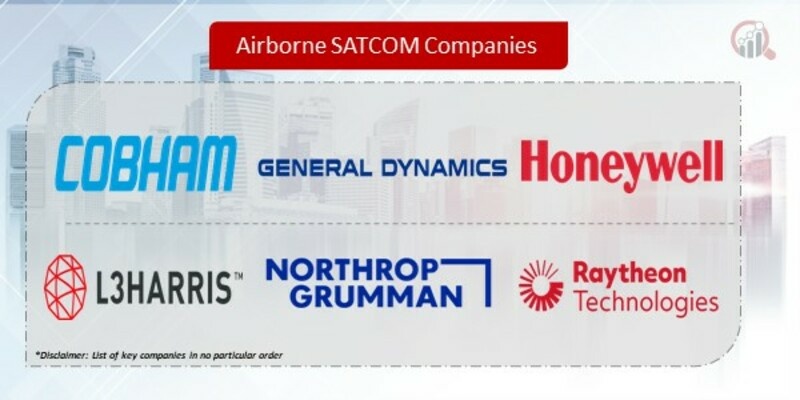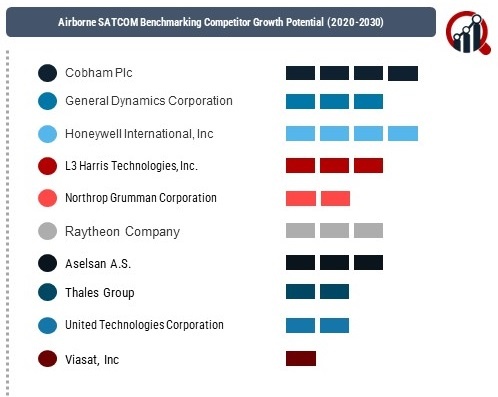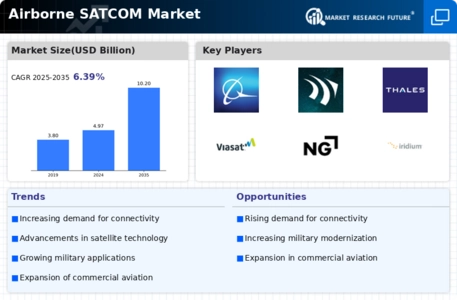Top Industry Leaders in the Airborne SATCOM Market

The competitive landscape of the Airborne Satellite Communication (SATCOM) market plays a pivotal role in the aerospace and defense industry, facilitating secure and reliable communication for airborne platforms. Key players in this market employ diverse strategies to navigate challenges and meet the increasing demand for advanced airborne SATCOM solutions.
Key Players:
Cobham Plc (UK)
General Dynamics Corporation (US)
Honeywell International, Inc. (US)
L3 Harris Technologies, Inc. (US)
Northrop Grumman Corporation (US)
Raytheon Company (US)
Aselsan A.S. (Turkey)
Thales Group (France)
United Technologies Corporation (US)
Viasat, Inc. (US)
Strategies Adopted:
The Airborne SATCOM market deploy strategic initiatives to address the evolving needs of defense agencies, airlines, and other operators. Notable strategies include continuous investment in research and development (R&D), diversification of SATCOM product portfolios, strategic partnerships, and a focus on meeting emerging market demands. Honeywell International, for instance, emphasizes R&D investments to enhance airborne SATCOM capabilities, showcasing a commitment to technological advancement. Strategic collaborations between L3Harris Technologies and defense agencies aim to optimize airborne SATCOM implementations for specific operational requirements, demonstrating a cooperative approach to addressing the diverse needs of airborne communication.
Market Share Analysis:
The Airborne SATCOM market is influenced by factors such as system performance, cybersecurity features, adaptability to different airborne platforms, pricing competitiveness, and the ability to provide comprehensive solutions for various applications. Companies excelling in delivering high-quality, technologically advanced airborne SATCOM systems, ensuring compliance with stringent defense and aviation standards, and offering flexibility to meet the specific requirements of different aircraft models are strategically positioned to capture a larger market share. Establishing strong relationships with defense agencies and aviation operators, participating in industry collaborations, and understanding the regulatory landscape of airborne SATCOM are crucial for maintaining a competitive edge in this sector.
News & Emerging Companies:
The Airborne SATCOM market has witnessed the emergence of new companies aiming to address the growing demand for innovative and cost-effective communication solutions. Emerging entrants, such as Iridium Communications Inc. and Inmarsat plc, have gained attention for their focus on introducing advanced SATCOM technologies that cater to the specific needs of modern airborne platforms. These emerging companies contribute to the market by introducing fresh perspectives and agile approaches to address the evolving requirements of communication in airborne operations.
Industry Trends:
The Airborne SATCOM market underscores ongoing investment trends, with a strong emphasis on improving SATCOM system capabilities, enhancing cybersecurity features, and addressing the challenges of global coverage. Companies are investing significantly in the development of SATCOM technologies with increased bandwidth, secure communication protocols, and adaptability to different frequency bands. Enhanced cybersecurity features, including encryption and threat detection, are a focus to safeguard airborne communication systems against evolving threats. Investments in addressing the challenges of global coverage reflect the industry's response to the growing need for seamless and continuous communication capabilities across various airborne platforms.
Competitive Scenario:
The Airborne SATCOM market is marked by intense competition among established players and the entry of innovative newcomers. With the increasing reliance on connectivity for mission-critical operations, companies aim to differentiate themselves by offering comprehensive SATCOM solutions that address the challenges of modern airborne communication. Established players focus on refining their SATCOM system designs, expanding their market presence through strategic collaborations with defense agencies and commercial operators, and staying informed about emerging technologies and regulatory requirements. The entry of emerging companies adds dynamism to the market, fostering an environment of continuous improvement and responsiveness to the changing demands of the aerospace and defense industry.
Recent Development
The Airborne SATCOM market witnessed a significant development as Viasat, Inc. announced the successful deployment of its advanced airborne SATCOM system on a fleet of commercial aircraft. The deployment showcased the SATCOM system's enhanced capabilities, including high-speed broadband connectivity and secure communication for both passengers and crew. This development highlights Viasat's commitment to advancing airborne SATCOM technologies and reinforces its position as a key player in the market. The successful deployment is expected to contribute to the overall enhancement of in-flight connectivity, offering an improved passenger experience and supporting the growing demand for reliable and high-bandwidth communication on commercial aircraft. The announcement reflects the industry's continuous efforts to evolve and provide cutting-edge solutions that address the challenges posed by the dynamic airborne communication landscape, emphasizing the importance of advanced airborne SATCOM technologies in ensuring seamless connectivity for both military and commercial airborne platforms.










